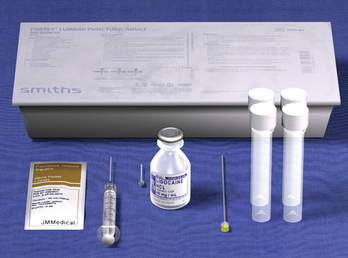Chapter 36 Lumbar Puncture
Equipment
The equipment for performing a lumbar puncture is packaged in a complete instrument tray that includes a preparation kit, an anesthetic, a spinal needle, an optional pressure catheter system, and collection tubes labeled to indicate the order of the fluid withdrawn (Figure 36-1).
Key steps
1. Anatomic landmarks: Place the patient in the flexed lateral decubitus position. Palpate the iliac crest and the lumbar spines at the midline. The iliac crest serves as the landmark that marks the interspace between the third and fourth lumbar (L3, L4) vertebrae. Mark this interspace (Figure 36-2).
Stay updated, free articles. Join our Telegram channel

Full access? Get Clinical Tree



